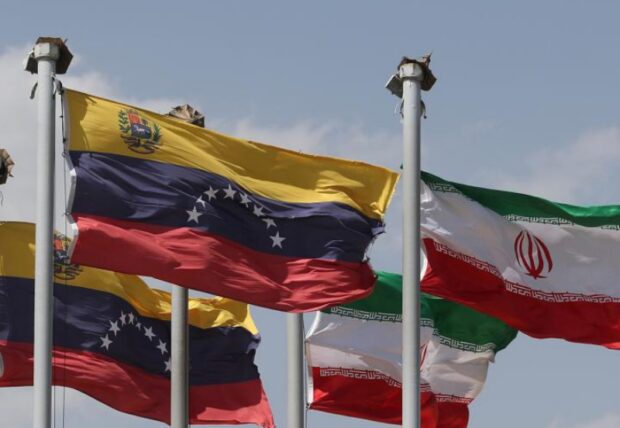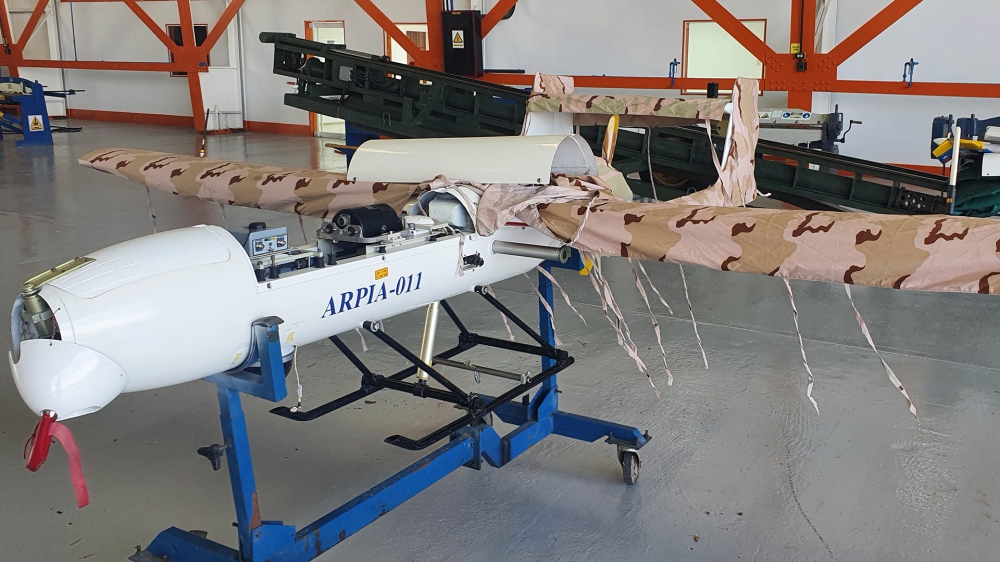Tehran, Caracas, and Moscow have been running a secretive air bridge just as Iran appears to be surging its transfer of attack drones to Russia, raising questions about whether these activities are linked.
As the United States considers whether to ease sanctions on Venezuela in order to boost global oil supplies, officials should take a closer look at potentially related events across the Atlantic in Ukraine, where Iranian-made Shahed-136 kamikaze drones are regularly buzzing over cities and detonating their high-explosive payloads on civilian infrastructure. Venezuela has been under U.S. sanctions for years, in part due to its close ties with the Iranian regime.
Apparently undeterred, President Nicolas Maduro led a high-ranking delegation to Tehran this summer, resulting in a long-term cooperation agreement that included the resumption of weekly airline flights between the two capitals in July (the route had been suspended since 2015, presumably due to foreign pressure). Although the stated reason for this initiative was to promote tourism, significant evidence suggests that the flights could also be used to transport drone materiel and other military hardware.
Conviasa’s Deep Military Involvement with Iran
Venezuela’s state-owned flag carrier Conviasa Airlines is heavily involved in Iran’s global illicit arms network, operating a joint venture with Mahan Air, the Iranian carrier that doubles as a logistical arm of the Islamic Revolutionary Guard Corps (IRGC). Among other activities, Mahan has a history of using civilian passenger flights to transport weapons and ammunition to allies such as the Assad regime in Syria and Hezbollah in Lebanon, and many of its flight crews are ex-IRGC pilots. The company has been under U.S. sanctions since October 2011 for secretly ferrying operatives, weapons, and funds via such flights on behalf of the IRGC’s Qods Force.
In February 2020, Conviasa and its forty-plane fleet—much of it supplied and maintained by Mahan—were blacklisted by the U.S. Treasury Department for supporting the Maduro regime’s destabilizing activities. Yet the airline’s suspected involvement in Iranian military activity stretches much further back. As early as 2008, the U.S. Congress and State Department expressed concerns that Tehran was using Conviasa’s weekly Caracas-Damascus-Tehran flights to transport missile components to Syria. For example, a La Stampa article published on December 21, 2008, cited Western intelligence assessments that these flights were filled with visa-exempt military personnel and sensitive military materiel.
More recently, Mahan helped Conviasa form a cargo subsidiary in November 2021. Named Emtrasur, it began operations in January 2022 with a single leased Mahan Air Boeing 747-300B3(M) (current registration number YV3531, formerly EP-MND) flying out of El Libertador Air Base. The company has functioned as the strategic airlift arm of Venezuela’s air force, with regular flights to Tehran, Moscow, and Belgrade.
It made headlines this June when its only plane was detained in Buenos Aires while reportedly hauling car parts. That flight’s unusually large cockpit crew of nineteen Iranian and Venezuelan nationals included Gholamreza Ghasemi Abbasi, a retired IRGC Aerospace Force general and the current managing director of Qeshm Fars Air, another airline that operates on behalf of the IRGC. Abbasi is known as the mastermind of Iran’s efforts to arm its proxies using civilian airliners. The crew members detained in the June incident were recently released, with Emtrasur claiming that the Iranian contingent had been training the Venezuelans. Yet Washington has asked Caracas to extradite the plane for further examination.
El Libertador also houses an aviation services factory belong to EANSA, a joint venture between Conviasa and the state-owned Compania Anonima Venezolana de Industrias Militares (CAVIM). EANSA maintains drones operated by the Venezuelan armed forces, including the Iranian Mohajer-2 (known locally as Arpia or ANSU-100) and the recently unveiled ANSU-200 flying-wing design, which is very similar to the IRGC’s Shahed-171 and is reportedly under development in Venezuela using experts trained in Iran. Near El Libertador is a CAVIM arms factory that oversees the country’s drone program.
Suspicious Russian Routes
On October 2, after months of suspension due to international sanctions, Moscow resumed seasonal charter flights to the popular Venezuelan tourist destination of Margarita Island, relying mainly on Conviasa’s jets given the continued European restrictions on Russian airlines. Many are concerned that these flights might also be used as cover for military activities—especially now that Tehran’s Imam Khomeini International Airport (IKA) has been added as an unscheduled stopover even on supposedly “direct” routes. Indeed, given the increasing pace of Conviasa flights between Caracas, Tehran, and Moscow, the airline may be involved in shipping Iranian arms and equipment to Russia (in theory, some of this equipment may be assembled in Venezuela as well).
According to confidential eyewitnesses, when some Conviasa flights carrying passengers arrive at IKA, they do not use the normal passenger ramp on the west side of the airport. Instead, they stop at the cargo ramp on the east side, where they are met by vehicles that load and offload pallets and containers under armed IRGC protection.
The uptick in these suspicious flights has coincided with Russia’s increasing use of Iranian kamikaze drones in Ukraine, suggesting a potential connection. In all likelihood, Iran’s drone production capacity cannot meet Moscow’s growing demand, perhaps spurring Tehran to establish a secret production line in Venezuela for the Shahed-136 or its airframe. Alternatively, such arrangements could give Tehran plausible deniability for its illegal drone deliveries.
Whatever the case, Conviasa took delivery of two Airbus A340-600 super long-haul jets from Mahan earlier this year to serve its overseas routes (registration numbers YV3533, formerly EP-MMF, and YV3535, formerly EP-MMI). The A340-600 has a range of 14,500 kilometers and can fly directly from Caracas to Moscow (9,900 kilometers) or Tehran (just under 12,000 kilometers). The jet’s normal cargo capacity is twelve tons—in addition to 308 passengers, it can hold up to forty-three standard LD3 containers and fourteen pallets. With the seats removed, it can carry forty extra tons of freight in the passenger cabin. Either way, it has ample room for transporting drone parts, other weapons, and ammunition boxes.
For their return leg from Moscow, these flights apparently fill their passenger seats with Russian tourists bound for Margarita Island, generating substantial commercial revenue in the process. And by using Conviasa, tour operators can circumvent international sanctions against Russian aviation, enabling the flights to pass through European airspace—and make unscheduled stopovers in Iran.
For example, according to tracking websites such as Flightradar24, YV3535 took off from Caracas for its Moscow direct route on September 30, but then diverted to Tehran while switching off its ADS-B tracking system. Conviasa planes have also made diversions to Tehran after taking off from Moscow, such as YV3533 on September 18 and YV3535 on October 17, 28, and 30. This practice enables the flights to avoid appearing on IKA’s scheduled arrivals list.
Notably, after landing in Tehran on September 30, YV3535 loaded up some cargo but did not take on any new passengers. Two hours later, it took off again for Moscow’s Vnukovo International Airport. Other flights on this diversionary route have followed a similar schedule. According to aviation experts familiar with cargo handling at IKA, two hours is ample time to fill up this aircraft’s hold with containers or pallets. In this scenario, drone airframe components could be arriving from Venezuela, while engines and associated parts are then loaded up in Tehran.
Iran-Venezuela Drone Links
Since mid-September, Russia has been escalating its use of Iranian-made Shahed-131 and -136 kamikaze drones against Ukraine, adding Kyiv and the country’s power plants and radar stations to the target list. The Mohajer-6 surveillance and attack drone has been used there as well (e.g., on September 23, Ukrainian forces fished an intact one out of the Black Sea near Odessa). On October 11, President Volodymyr Zelensky accused Tehran of selling Moscow no less than 2,400 drones. Whether or not that figure is accurate, the presence of slow but deadly Shahed drones has become a major concern for Ukraine.
Yet Tehran continues to deflect responsibility for Russia’s widespread use of these kamikaze drones, flatly denying any deliveries at first, and more recently admitting some of the transfers but insisting that they took place well before the Ukraine invasion. Unsurprisingly, even this qualified admission does not add up—according to Ukrainian sources, the Mohajer-6 recovered near Odessa had been assembled in February, the same month the war began. Whatever equivocations Iranian officials may offer going forward, their overriding intent is clear: to maintain the illusion of “neutrality” in the conflict and avoid incurring further sanctions pressure. Not coincidentally, this goal would be ably abetted if Venezuela were acting as a go-between.
Tellingly, Tehran and Caracas were cooperating in the field of unmanned aerial vehicles for years before the current crisis. In the early 2000s, President Hugo Chavez counted on Iran’s military assistance to counter what he described as the “Colombian bourgeoisie and their American allies.” In 2012, he confirmed reports that an Iranian drone production line had already been established in his country.
A year later, the government unveiled a number of unarmed Mohajer-2 reconnaissance drones, each produced by CAVIM. More recently, they were armed with four small bombs hung under their wings. U.S. Southern Command watched all of these developments closely and with some concern.
In November 2020—one month after Washington announced new sanctions against Venezuela for buying Mohajer drones and other Iranian arms—President Maduro spoke of plans to expand CAVIM’s domestic drone production efforts, ostensibly with Iran’s help.
In January 2021, the U.S. State Department took major new steps to “contain Iran’s malign activities” by sanctioning almost the entirety of the regime’s military industrial sector, citing its track record of supplying combat drones and other weapons to proxies in the Middle East and elsewhere. The same designation cited Maduro’s government for participating in such activities. In February 2013 and again in August 2016, the department sanctioned CAVIM under the Iran, North Korea, and Syria Nonproliferation Act (INKSNA).
Policy Recommendations
In an effort to curb the spread of Iranian arms to Ukrainian battlefields and cities, the United States has levied additional sanctions on multiple sectors in the Islamic Republic:
- Drone-related industries
- Mahan Air, Pouya Air, Qeshm Fars Air, and Iran Air Cargo, along with their facilitators in neighboring countries such as the United Arab Emirates
- Numerous individual cargo aircraft serving Russia
Washington has also warned that any provision of spare parts or refueling, maintenance, and repair services to these entities would violate U.S. export controls and subject the parties to enforcement actions. Yet Tehran seems undeterred by these restrictions, so more strenuous measures may be needed to monitor and effectively curtail the Iranian networks that enable weapons proliferation to Russia—particularly given the likelihood that outside actors such as Venezuela may be involved.
To begin with, the United States should ask European governments to impose similar sanctions on the Iranian airlines mentioned above—and on Conviasa if its involvement in transferring drones and other arms to Russia is proven. In addition, officials should persuade Azerbaijan and Turkmenistan to close their airspace to direct flights from Tehran to Moscow across the Caspian Sea, thereby rendering that span of the Venezuela-Iran-Russia air bridge inoperative. To be sure, the parties may find alternative sea and land routes that cannot be so easily shut down. Yet such routes can be more readily monitored, and using them would incur more costs on the states involved.
Source: Washington Institute


